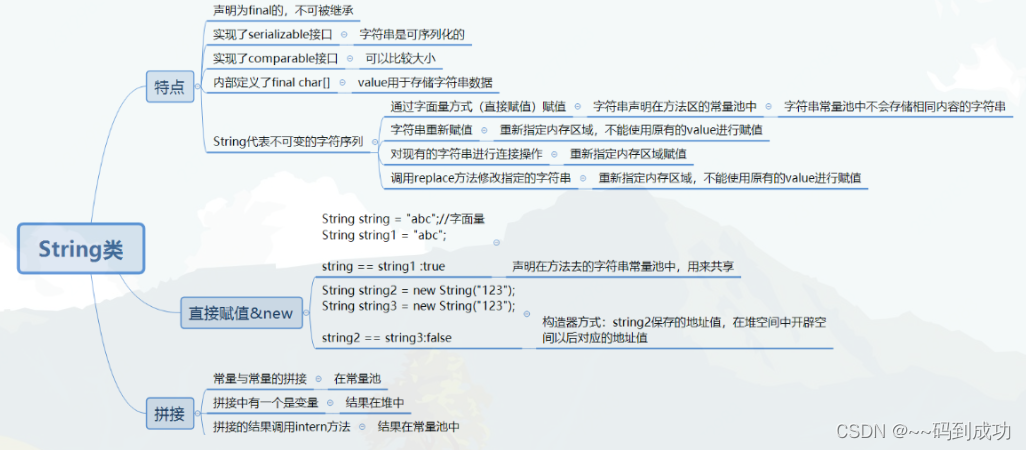目录
三、StringBuffer 和 StringBuilder
一、与字符串相关的类
我们知道与字符串相关的类有三个:
- String
- StringBuffer
- StringBuilder
1.1 三者特点
【1】String

【2】StringBuffer
可变的字符序列,线程安全的,效率低。
【3】StringBuilder
可变的字符序列,线程不安全的,效率高。
1.2 三者转换
- String转换为StringBuffer、StringBuilder:** 调用StringBuffer、StringBuilder的构造器。
- StringBuffer、StringBuilder转换为String:** 调用String的构造器或调用StringBuffer、 StringBuilder的toString方法。
二、String 各种方法
2.1 length 和 concat
String s="我是最棒的,I‘m the best。";
System.out.println("长度为:"+s.length());//获取字符串长度
System.out.println(s+"==yes");//字符串连接
System.out.println(s.concat("==yes"));//字符串连接长度为:19
我是最棒的,I‘m the best。==yes
我是最棒的,I‘m the best。==yes2.2 替换 replace 相关
【1】public String replace(char searchChar, char newChar):
返回一个新的字符串,它是通过用 newChar 替换此字符串中出现的所有 oldChar 得到的。
public class Main {
public static void main(String args[]) {
String Str = new String("Runoob");
System.out.print("返回值 :" );
System.out.println(Str.replace('o', 'T'));
System.out.print("返回值 :" );
System.out.println(Str.replace('u', 'D'));
}
}返回值 :RunTTb
返回值 :RDnoob【2】String replaceAll(String regex, String replacement):
使用给定的 replacement 替换此字符串所有匹配给定的正则表达式的子字符串。
public static void main(String args[]) {
String Str = new String("www.google.com");
System.out.print("匹配成功返回值 :" );
System.out.println(Str.replaceAll("(.*)google(.*)", "runoob" ));
System.out.print("匹配失败返回值 :" );
System.out.println(Str.replaceAll("(.*)taobao(.*)", "runoob" ));
}匹配成功返回值 :runoob
匹配失败返回值 :www.google.com【3】public String replaceFirst(String regex,String replacement)
replaceFirst() 方法使用给定的参数 replacement 替换字符串第一个匹配给定的正则表达式的子字符串。
public class Test {
public static void main(String args[]) {
String Str = new String("hello runoob,I am from runoob。");
System.out.print("返回值 :" );
System.out.println(Str.replaceFirst("runoob", "google" ));
System.out.print("返回值 :" );
System.out.println(Str.replaceFirst("(.*)runoob(.*)", "google" ));
}
}返回值 :hello google,I am from runoob。
返回值 :google2.3 其它方法
String s1="oh my god! ";
String s2="oh my gosh!";
System.out.println(s1.charAt(6));//返回指定索引的字符(0 ~ length()-1)
System.out.println(s1.startsWith("god!"));//是否以指定前缀开始
System.out.println(s1.startsWith("god!",6));//toffset: 字符开始查找位置 是否以指定前缀开始,
System.out.println(s1.endsWith("god!"));//是否以指定后缀结束
System.out.println(s1.equals(s2));//字符串比较
System.out.println(s1.equalsIgnoreCase(s2));//字符串比较(不考虑大小写)
System.out.println(s1.indexOf("o"));//返回指定字符在字符串中第一次出现处的索引
System.out.println(s1.indexOf("o",7));//从指定索引开始查找,返回指定字符在字符串中第一次出现处的索引
System.out.println(s1.lastIndexOf("o"));//返回指定字符在字符串中最后一次出现处的索引
System.out.println(s1.lastIndexOf("o",7));//从指定索引开始查找,返回指定字符在字符串中最后一次出现处的索引
System.out.println(s1.matches("(.*)my(.*)"));//是否匹配给定的正则表达式
for (String s3:s1.split("y")){
System.out.println(s3);//把字符串按 regex 拆分成多份
}
System.out.println(s1.substring(5));//返回从指定索引开始的子字符串
System.out.println(s1.substring(5,8));//返回从索引5开始到索引8结束的子字符串,不包括结束索引的字符串
System.out.println(s1.toUpperCase());//全部大写
System.out.println(s1.toLowerCase());//全部小写
System.out.println(s1.trim());//取出前后空白字符
System.out.println(s1.contains("my"));//是否包含指定字符
System.out.println(s1.isEmpty());//判断字符串是否为空g
false
true
false
false
false
0
7
7
7
true
oh m
god!
god!
go
OH MY GOD!
oh my god!
oh my god!
true
false三、StringBuffer 和 StringBuilder
- 当对字符串进行修改的时候,需要使用 StringBuffer 和 Stringbuilder 类
- 和 String 类不同的是,StringBuffer 和 StringBuilder 类的对象能够被多次的修改,并且不产生新的未使用对象。
- 在使用 StringBuffer 类时,每次都会对 StringBuffer 对象本身进行操作,而不是生成新的对象,所以如果需要对字符串进行修改推荐使用 StringBuffer。
- StringBuilder 类在 Java 5 中被提出,它和 StringBuffer 之间的最大不同在于 StringBuilder 的方法不是线程安全的(不能同步访问)。
- 由于 StringBuilder 相较于 StringBuffer 有速度优势,所以多数情况下建议使用 StringBuilder 类。
1. StringBuffer
StringBuffer sBuffer = new StringBuffer("菜鸟教程官网:");
sBuffer.append("www");
sBuffer.append(".runoob");
sBuffer.append(".com");
System.out.println(sBuffer); 菜鸟教程官网:www.runoob.com| 序号 | 方法描述 |
| 1 | public StringBuffer append(String s) 将指定的字符串追加到此字符序列。 |
| 2 | public StringBuffer reverse() 将此字符序列用其反转形式取代。 |
| 3 | public delete(int start, int end) 移除此序列的子字符串中的字符。 |
| 4 | public insert(int offset, int i) 将 int 参数的字符串表示形式插入此序列中。 |
| 5 | insert(int offset, String str) 将 str 参数的字符串插入此序列中。 |
| 6 | replace(int start, int end, String str) 使用给定 String 中的字符替换此序列的子字符串中的字符。 |
2. StringBuilder
StringBuilder sb = new StringBuilder(10);
sb.append("Runoob..");
System.out.println(sb);
sb.append("!");
System.out.println(sb);
sb.insert(8, "Java");
System.out.println(sb);
sb.delete(5,8);
System.out.println(sb); Runoob..
Runoob..!
Runoob..Java!
RunooJava!四、判断字符串是否为空的几种方法
【1】最多人使用的一个方法, 直观, 方便, 但效率很低:(后来跟主管讨论说不让使用第一种,原因是==和equals比根本上的不同,一个是比较内存地址一个是比较内容,如果在使用云服务和搭建集群的时候有可能会出问题,虽然性能上会差几ms,但还是让使用第一种,第四种适合简单一般的比较)
if(s == null || "".equals(s));【2】比较字符串长度, 效率高, 是我知道的最好一个方法:
if(s == null || s.length() == 0);【3】Java SE 6.0 才开始提供的方法, 效率和方法二几乎相等, 但出于兼容性考虑, 推荐使用方法二.
if(s == null || s.isEmpty());【4】这是一种比较直观,简便的方法,而且效率也非常的高,与方法二、三的效率差不多:
if (s == null || s == "");五、几种字符转换
5.1 string 与 int 互转
string --> int
String number = "-7";
// result = -7
int result = Integer.parseInt(number);
// result2 = -7
Integer result2 = Integer.valueOf(number);
int --> string
int i=1;
String s = String.valueOf(i);
String s = Integer.toString(i);
String s = “” + i;
5.2 string 与 double 互转
string --> double
String toBeDouble =“200.20”;
Double fromString = new Double(toBeDouble);
double -->string
Double toBeString = 400.40;
String fromDouble = "" + toBeString;
5.3 string 与 float 互转
string --> float
Float.valueOf(String).floatValue();
Float.parseFloat(String);
float --> string
Float.toString(float);
5.4 int 与 double 互转
int--> double
int i = 123;
//1.隐式转换
double d1 = i;
//2.使用Double.valueOf()方法
double d2 = Double.valueOf(i);
double --> int
double doubleValue = 82.14; // 82.14
System.out.println("doubleValue: "+doubleValue);
//typecase double to int
int intValue = (int) doubleValue; // 82
System.out.println("intValue: "+intValue);
double doubleValue = 82.14; // 82.14
System.out.println("doubleValue: "+doubleValue);
//创建Double wrapper对象
Double doubleValueObject = new Double(doubleValue);
//将case双精度型转换为int
int intValue = doubleValueObject.intValue(); // 82
System.out.println("intValue: "+intValue);
5.5 int 与 float 互转
float --> int
float a = 8.61f;
int b = (int)Math.round(a);
int --> float
int a=9;
int b=7;
DecimalFormat df=new DecimalFormat("0.00");
System.out.println(df.format((float)a/b));
System.out.println(df.format(a/(float)b));
System.out.println(df.format((float)a/(float)b));
System.out.println(df.format((float)(a/b)));
5.6 double 与 float 互转
String str = "9.2";
Long.parseLong(str ); //异常java.lang.NumberFormatException: For input string: "9.2"
Float.parseFloat(str); //可以
Double.parseDouble(str);//可以
如果有错还请指正,同时也欢迎大家到我的个人博客 ~ 欢迎来到我的小栈 ~ 访问留言。





















 201
201











 被折叠的 条评论
为什么被折叠?
被折叠的 条评论
为什么被折叠?








